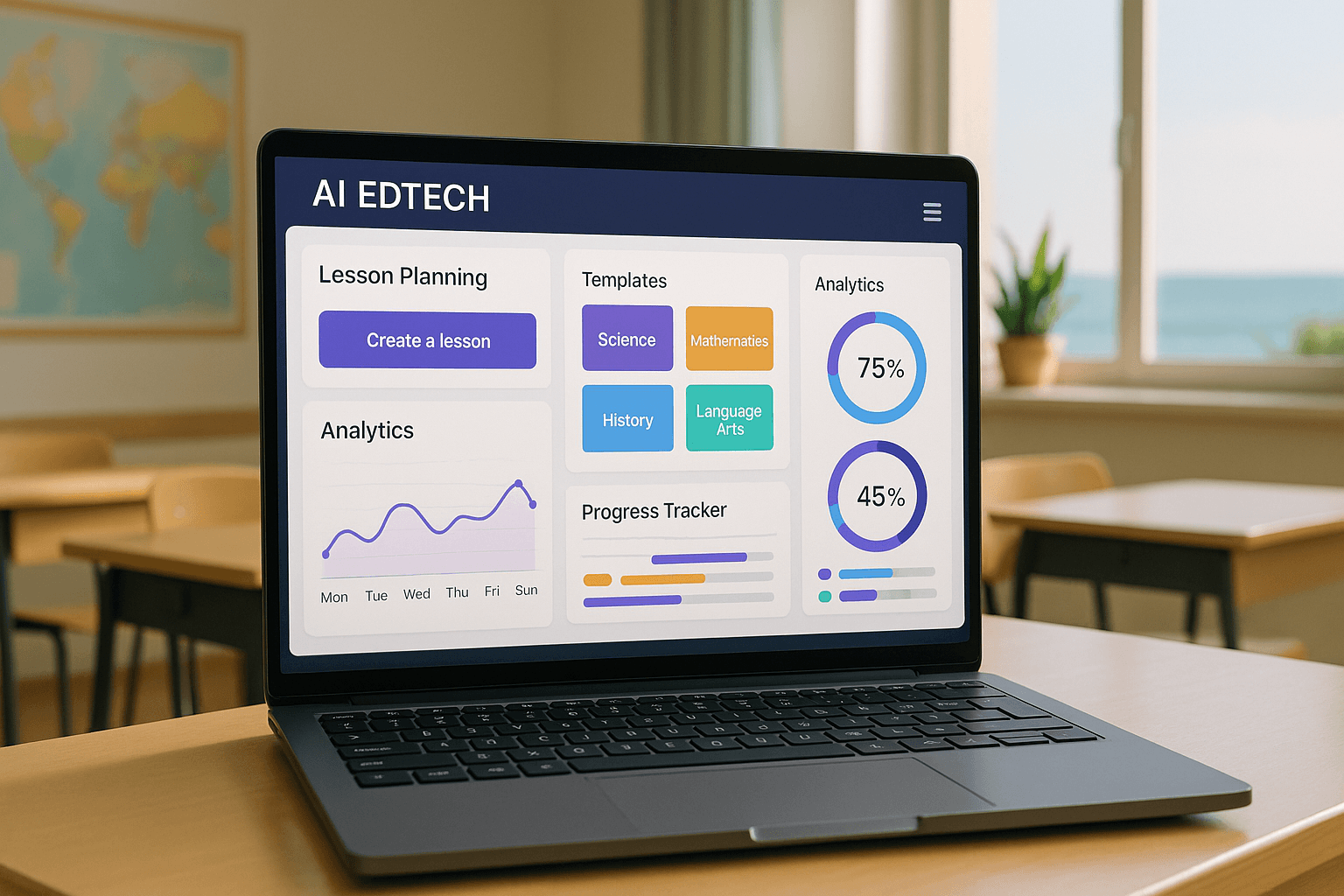Caption: AI-driven tools streamline lesson planning, freeing teachers to focus on instruction.
Last spring, I stood in a Glynn County, Georgia, middle school, watching a teacher juggle lesson plans for 25 students, each with distinct needs, from Spanish-speaking newcomers to kids with learning challenges. Her passion was undeniable, but her time was stretched thin. That moment cemented my mission: to bring AI-driven adaptive learning tools to K-12 classrooms. As an EdTech advocate who’s led hands-on workshops with GDG Brunswick, I’ve seen AI save teachers hours and ignite student excitement. This article explores how AI enhances teacher efficiency, engages learners, and addresses adoption challenges, paving the way for smarter, more inclusive classrooms across Coastal Georgia and beyond.
Streamlining Teacher Workflows with AI
AI tools are a game-changer for teachers swamped by administrative tasks. In my workshops, I’ve shown educators how platforms like Google for Education (Google for Education) craft custom lesson plans in minutes, not hours. Pardosi et al. (2024) found that these systems shave 15% off planning time, a lifeline for rural Glynn County teachers who are short on resources. Mustafa et al. (2024) note that AI analytics highlight student struggles—such as a child falling behind in math—prompting targeted support. For Coastal Georgia’s underfunded schools, AI isn’t just efficient; it’s a way to level the playing field, ensuring every teacher can focus on what matters: teaching.
Engaging Students with Personalized Learning
In Brunswick, I’ve seen AI tools tweak math quizzes on the fly, matching each kid’s pace so no one’s left frustrated or unchallenged. These platforms use live data to fine-tune difficulty, keeping lessons fresh. Zhang et al. (2023) reported a 20% jump in engagement with AI platforms, thanks to tailored feedback. Luo (2023) found 15% stronger academic results compared to traditional methods. In Coastal Georgia’s diverse classrooms—think multilingual learners or students with IEPs—AI sparks motivation. I’ve seen kids in Brunswick light up when an AI tool gamifies their math homework, proving tech can boost retention and joy in learning.
Overcoming Barriers to AI Adoption
Adopting AI isn’t easy. Pujeda (2023) found that 60% of teachers lack knowledge of AI, and Wulandani et al. (2024) noted that 50% of schools struggle with inconsistent internet access. Privacy concerns also nag educators (Zhang, 2024). My solution? Hands-on training. Meylani (2024) says targeted PD builds digital confidence, and my GDG Brunswick sessions prove peer learning calms tech fears. UNESCO’s report (2024) emphasizes the need for continuous training to ensure equitable access to AI. In Glynn County, where connectivity is limited, these steps are crucial to integrating AI into the classroom as a staple.
A Path Forward for AI-Driven Classrooms
In a Brunswick classroom, I watched a teacher’s eyes light up as an AI tool reduced her grading time, allowing her to plan a hands-on science experiment instead. That’s the magic of AI in K-12 education—a lifeline for teachers, not a replacement. My Coastal Georgia workshops with GDG Brunswick demonstrate that tech can spark joy when educators receive the proper support. But we need action: better Wi-Fi in Glynn County schools, practical training, and community buy-in from parents to principals. Studies show that AI reduces preparation time and improves grades (Pardosi et al., 2024; Luo, 2023). Let’s make every classroom a place where teachers and kids shine.
Scaling AI Through Partnerships
To spread the benefits of AI, schools need allies. Public-private partnerships, such as Microsoft’s Education Transformation Framework (Microsoft, 2024)—pair rural districts with tech firms to fund tools and connectivity. In Coastal Georgia, a local tech hub could partner with schools to equip classrooms and train teachers, ensuring that no one is left behind. These collaborations reward ingenuity, not demographics, aligning with fair, merit-driven innovation. By building these bridges, we create sustainable AI ecosystems that lift every student and teacher.
Let’s harness AI to craft classrooms where every learner shines, from Brunswick to beyond, with tools like Google’s and local EdTech communities.
Sources
- Eling, F., & Ogwal, A. (2025). Bridging learning gaps: The role of AI-powered technologies in enhancing quality education. International Journal of Research and Innovation in Social Science. https://doi.org/10.47772/ijriss.2025.903sedu0155
- Luo, Q. (2023). The influence of AI-powered adaptive learning platforms on student performance in Chinese classrooms. Journal of Education. https://doi.org/10.53819/81018102t4181
- Meylani, R. (2024). Artificial intelligence in the education of teachers: A qualitative synthesis of the cutting-edge research literature. Journal of Computer and Education Research. https://doi.org/10.18009/jcer.1477709
- Microsoft Education. (2024). Education Transformation Framework for AI Integration. Microsoft Education. https://education.microsoft.com/en-us
- Mustafa, G., Urooj, T., & Aslam, M. (2024). Role of artificial intelligence for adaptive learning environments in higher education by 2030. Journal of Social Research Development. https://doi.org/10.53664/jsrd/05-03-2024-02-12-22
- Pardosi, V., Xu, S., Umurohmi, U., Nurdiana, N., & Sabur, F. (2024). Implementation of an artificial intelligence based learning management system for adaptive learning. Al-Fikrah Jurnal Manajemen Pendidikan. https://doi.org/10.31958/jaf.v12i1.12548
- Pujeda, J. (2023). A systematic review on teachers’ digital competencies on the adoption of artificial intelligence in enhancing learning experiences. International Journal of Research and Innovation in Social Science. https://doi.org/10.47772/ijriss.2023.7012031
- Wulandani, N., Mu’ti, Y., & Ulfa, R. (2024). AI in education: Revolutionizing personalized learning experiences. EDUJAVARE: International Journal of Educational Research. https://doi.org/10.70610/edujavare.v2i2.797
- Zhang, C. (2024). AI in education: Opportunities, challenges, and pathways for equitable learning. Journal of Education Humanities and Social Sciences. https://doi.org/10.54097/kfgp6j07
- Zhang, S., Wang, X., Ma, Y., & Wang, D. (2023). An adaptive learning method based on knowledge graph. Frontiers in Educational Research. https://doi.org/10.25236/fer.2023.060624



